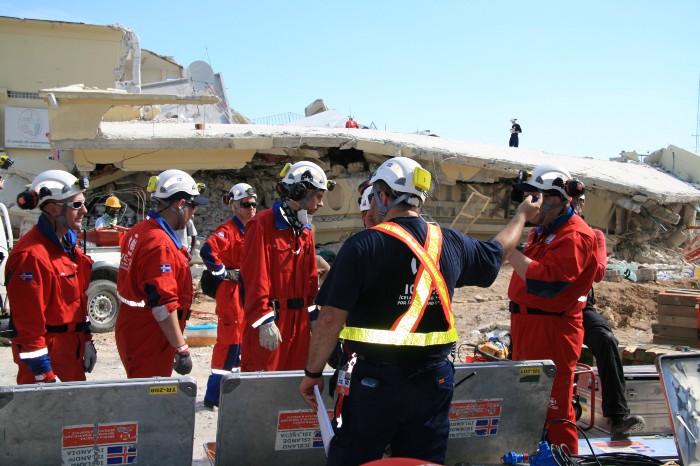Lean Response – Applying the Principles of Lean Startup Methodology to Humanitarian Response

This was post originally published on Medium.com
The whole humanitarian response system is undergoing a radical shift. We are moving from a top-down model to a bottoms-up survivor-centric model. In this new era, those affected by disasters become the center of focus, rather than the system trying to provide the response.
While reading up about the Lean Startup Methodology (see Lean Startup by Eric Ries and Lean Impact for more resources) I found that there were a number of great ideas that could help the humanitarian community make that shift, because in many ways the basic concept behind the Lean Startup Methodology is putting the customer and their needs at the center.
So lets discuss what it would mean for humanitarian response to become Lean, by taking some of the terminology and concepts from the Lean Startup Methodology and explain them in terms of Lean Response.
Respond?—?Measure?—?Learn
The Build-Measure-Learn cycle is a key component in the Lean Startup Methodology. It is all about creating a feedback loop. So instead of planning everything to the end, we run repeated loops of build, measure, learn.
In the case of Lean Response, the Build phase would be replaced by a Respond phase. We would start by providing the Minimum Viable Response (see below) that we can get into the hands of survivors quickly. This MVR allows us to test the assumptions that went into defining the MVR.
We then Measure?—?using actionable metrics (see below) to examine the results of survivors given the MVR.
Finally we Learn from these results. They will either lead us to continue on the same course, continue with some modifications, or pivot the strategy to a new direction.
It is important to realize that in the Lean Startup Methodology there is significant focus on shortening the Build-Measure-Learn cycle so that we can learn quickly.
It is also about repeating this cycle?—?making continuous improvements as you move towards a complete product, and soliciting, and incorporating survivor feedback at each step.
Survivor Development
In the Lean Startup Methology, the Customer Development component is all about incorporating the customer needs into the development of products or services.
Applying this component to Lean Response, it becomes all about incorporating the survivor needs into the response. In this model, teams talk with survivors early and often, responding with something they need, starting small with the Minimum Viable Response (MVR).
This continually ensures that the response provides value to survivors, thereby reducing wasted time and resources, and ensuring that the response succeeds.
Failing Fast
Failing fast is the idea that, instead of spending significant time and expense on an idea that isn’t viable in the real world, it’s better to fail fast and learn important information that can lead to a more viable response.
In Lean Response we would encourage teams to fail and to report their failures, so that we can adjust our response more quickly. Having short Respond-Measure-Learn cycles is key to failing fast.
Get Out of the Building
In order to create a valuable response, you need to talk to the people who will potentially benefit from it. Through the survivor development component, you solicit and incorporate survivor feedback throughout the process. By getting out of the building, you can minimize the risk that the response will fail by verifying your theories with actual survivors.
Monitoring/Evaluation
Instead of the cumbersome accountability metrics currently being employed, in Lean Response, we would focus on defining a few actionable metrics that are measurements that really reflect the key drivers of our work, from which we can develop actionable strategies. Actionable metrics are contrasted with vanity metrics, which provide data that makes an organization look good, but don’t truly reflect the organization’s performance.
Minimum Viable Response
A Minimum Viable Response (MVR) is the first response you provide to the survivor. It does not have to be perfect, it does not have to be complete, but it should provide the bare minimal support to the survivors.
Instead of trying to solve all of their long-term issues from the start, you begin with providing them with the basics and get a better understanding of what their needs are. This avoids the creation of complex response plans that are not relevant when they see the light of reality.
You then use the MVR to establish the dialogue with the survivors and then constantly improve it through the Respond-Measure-Learn cycles.
Pivot
Pivot means significantly changing the direction of a response strategy. Organizations will pivot when the current approach is not working.
Response-Need Fit
Response-Need fit means providing the response that satisfies the needs of the survivors.
Validated Learning
Validated learning involves testing an initial idea and using metrics to confirm of disprove the accuracy of the initial idea. Combined with Minimum Viable Response (MVR), validated learning provides important information about whether an idea is viable, and provides insight into how to create a response strategy that will benefit the survivors.
For additional information about some of the terms mentioned above see the Ultimate Dictionary of Lean for Social Good.
We would love getting comments from you on Lean Response below!
